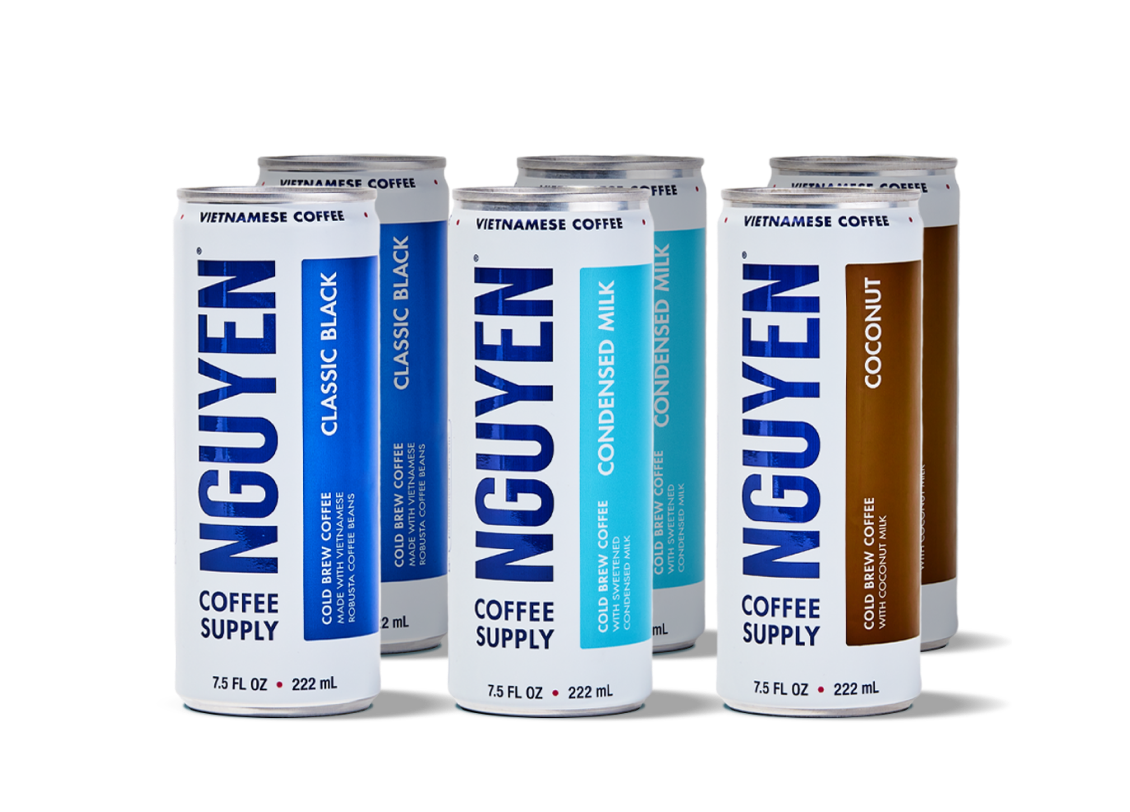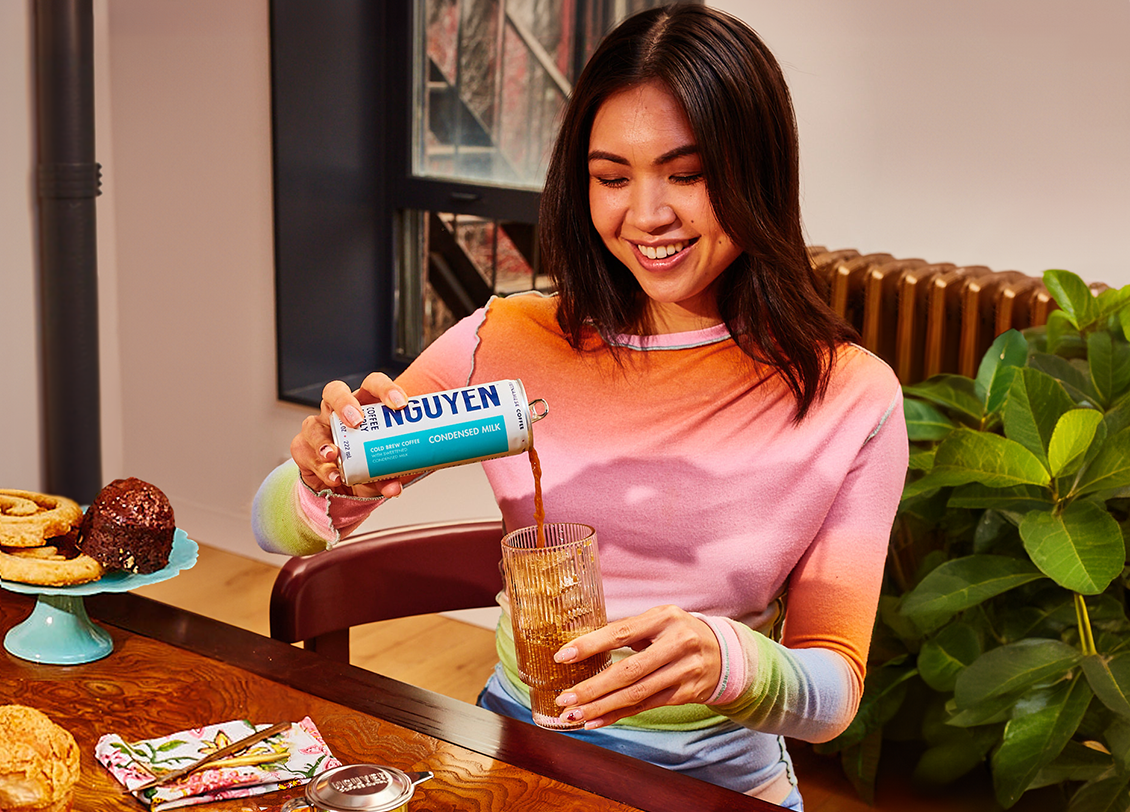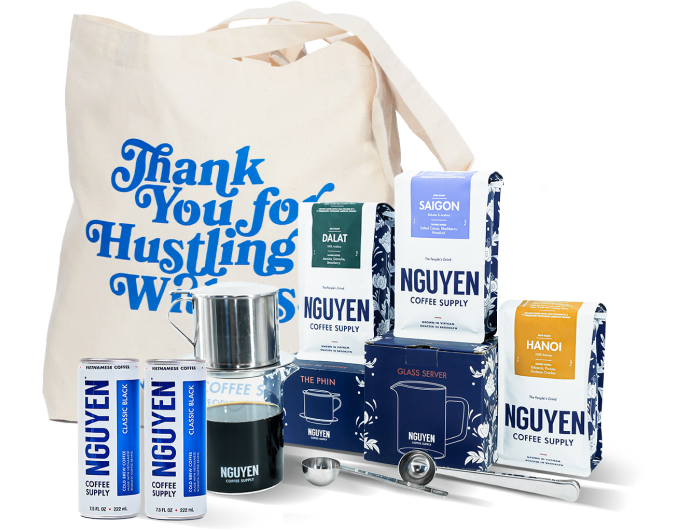


Create for yourself or as a gift for your loved ones
Subscribe nowMe and mom just enjoyed the Nguyen phin drip experience. Wow. Proud of your work. We without hesitation enjoy the Vietnamese coffee and recommend your products. Thank-you to the Nguyen staff and tradition. From Canada eh!
Iced coffee season is here, which means it is time to start brushing up on our iced coffee knowledge! Iced coffee is an umbrella term that is used for many various types of coffee beverages, but we’re here to break down the different types of iced coffee so you can order or make them like a pro.
As Vietnamese coffee lovers, we personally would of course be content drinking cà phê sữa đá all day, but we believe it’s worth taking the time to look at what other types of coffee there are as there’s no wrong way to enjoy coffee. Through our breakdown, you might surprise yourself and find a new go-to iced coffee style!
An iced coffee, at its core is: brewed coffee and ice. Regardless of the brew method, adding ice to the coffee could technically make it an iced coffee by virtue of the umbrella term. However, as we outline various types of iced coffee styles, you’ll find that they can be wildly different from each other.
Before delving into the different styles of iced coffee, it’s important to note that no matter how it is made, an iced coffee will always be built up from those two elements of brewed coffee and ice. The distinction, however, is how the coffee is made and even how the ice is treated or used in the process!
Making iced coffee using a pour over is a popular brew technique these days thanks to the third wave of coffee culture. Normally, the coffee would be brewed hot into a carafe, but Japanese baristas have come up with a technique that allows for making iced pour over. They wanted to create a type of iced coffee that was instantly iced but would not feel watered down or diluted, so, they calculated the weight of the ice cubes into the total brewing water.
In other words, they used less water to brew but then made it up with the ice cubes that would melt and cool the coffee. The result is an iced coffee that avoids major dilution while maintaining the bright flavor notes pour over fans have come to know and love.
Steps (for a Hario V60):
Best coffee for this brewing method: Hario V60 coffee yields a bright, smooth cup of coffee, so we recommend arabica coffee like Moxy.
Flavor profile: balanced and bright, pour over coffee makes for a perfect black coffee. It makes consistently good coffee that is always very pleasant to drink (even unsweetened) so long as the ratios are consistent as well. You can often find citrus notes and a very enjoyable acidity using this brew method.
The ostensibly simplest of all iced coffee brew methods, in theory, isn’t actually all the simple upon further investigation. This style of iced coffee requires a lot of practice and experience with whatever method you’re using to brew the coffee.
Basically, this style of iced coffee is made by brewing coffee in any brewing method—say, French press, for example—and then chilling it using ice cubes or refrigeration, the latter of which takes time. If using ice cubes to chill hot coffee, we run the risk of diluting it too much for our tastes. Luckily, there are ways to prevent this from happening!
In these cases, there exists the double strength method. This consists of using double the amount of coffee (say 4 tablespoons instead of 2) you would normally use to create a coffee twice as strong. This makes a very bold coffee that can resist being watered down without losing its flavor and aroma despite having ice poured into the cup immediately.
If you’re making iced coffee in this style and are a strong coffee lover (read: caffeine fiend), we strongly recommend you use the double strength method. If you’re refrigerating your coffee to chill it, we recommend adding ice to a normal amount of coffee, or diluting double strength coffee with water.The best coffee for this style, in our opinion, is robusta coffee. Robusta has a bold and strong flavor profile that can withstand dilution from adding ice to hot coffee. Additionally, robusta coffee has twice the caffeine of most coffees like arabica, so the fear of weak coffee is also moot as a flash chilled cup of robusta will retain its strength and flavor.
Unlike other iced coffee styles that are brewed hot and iced in order to make them cold, cold brew is already cold, so there’s no actual need for ice to do the initial work of chilling the coffee. Cold brew coffee is a unique style of brewing coffee that does not use hot water to brew the coffee, but relies on a very long infusion time. You may think that because it’s called cold brew it needs to be brewed cold in the fridge, but that’s not really the case as cold brew coffee can also be brewed at room temperature; that is, in fact, how it was discovered.
It is believed that cold brew coffee was first discovered in Japan. Coffee had made its way from China to Japan (via Nagasaki, most likely) and the Japanese merchant in question had no idea what to do with it, according to historical accounts. Vaguely following instructions, he simply ground it very coarsely and stored it in a vase filled with water. The next day, he went to check on it to discover the world’s first batch of cold brew as legend has it.
Nowadays, not much has changed. To make cold brew, you infuse coarsely ground coffee in water for long periods of time (8-24 hours). We like to do this in the fridge because it is generally more sanitary and avoids potential variation in flavor since the temperature is consistent.
Steps:
Best coffee for this brewing method: you can use whatever beans you like. If you like bold and nutty coffee, go with a 100% peaberry robusta like Truegrit. If you want a sweeter, fruity cup of coffee, opt for a 100% arabica coffee bean like Moxy. In any case, cold brew tends to bring out a different side to the beans you use as cold extraction makes for a more full-bodied and less acidic cup of coffee. Cold brew contains more caffeine than hot brewed coffee, though, so be advised that using robusta will make for a very strong brew!
Flavor profile: cold brew is exceptionally good at bringing out the natural flavors in coffee beans. You may notice an increase in natural sweetness and a decrease in overall bitterness and acidity. The coffee’s natural flavors will pop in a very pleasant way, especially if it’s a single origin specialty bean. One traditionally missing piece of the coffee experience of cold brew, however, is that you do have to sacrifice most of the aroma when making cold brew as hot brewed coffee creates stronger scents through the interaction of heat and water.
An iced americano takes a nod from Japanese iced coffee (pour over) and is done by adding water and ice albeit with less precise measurements. An americano, typically, is an espresso shot which has been watered down. The story goes that during WWII, American troops stationed in Italy were completely unable to drink the bitter, strong espresso that Italians loved so much as they were accustomed to drip coffee.
To adapt and compensate, they started watering down their espresso. The trend became popular even among Italians, who started calling it an “americano”—an American.
To make an iced americano, you don’t just add water, you also add ice. Since an americano is all about your personal taste, you can add however much ice or water you want or need. At many coffee shops, baristas will ask how much water and ice you’d like in the cup in addition to the number of espresso shots you prefer.
Steps:
Note: the traditional amount of water in an americano is 90ml, although you can definitely change the amount depending on how you like your coffee.
Best coffee for this brewing method: it’s honestly hard to say, because more than any other type of coffee, espresso really is all about personal preference. We recommend using 100% robusta coffee because it makes for a very strong, rich iced americano with plenty of crema in the initial pulled shots.
Flavor profile: the idea of the americano is to take a flavor that is extremely concentrated and spread it out, making it last longer. You can savor your coffee more this way. Luckily, this doesn’t mean that the flavor in question will feel any less present. This coffee has a full to medium body and has a bold flavor and aroma. For lovers of caffeine, an iced americano is a popular summertime choice for coffee.
Phin iced coffee is reminiscent of Japanese pour over iced coffee: you brew the coffee using hot water but directly over ice. The coffee cools instantly as it brews and, in a matter of a few minutes, you have a nice yet strong (read: undiluted) cup of iced coffee.
One of the advantages of using a Vietnamese phin filter is that you don’t have to worry about the one thing that can make iced coffee fall short: excessive dilution and a watered down taste. The phin filter brews coffee that is already strong, bold as the general ratio is 2:1 for water to coffee. This means that there is no pressing need to calculate the amount of ice and water you need with as much precision as with other methods—simply add as much ice as you wish without having to worry about an overly watery coffee.
Steps:
Best coffee for this brewing method: in general, we think it’s best to stick to robusta coffee when using the phin filter. You can also try a robusta/arabica blend like our Loyalty blend!
The grind size for the phin filter should be somewhere in between very fine (espresso) and medium grind (pour over). It should be fine like sand as this allows for a proper extraction in the phin filter. Too coarse and water will run right through, making a weak cup; too fine and water won’t be able to flow through well and the final cup of coffee will be over-extracted and harsh tasting.
Flavor profile: Phin coffee is naturally very strong, but also very aromatic and flavorful. The absence of paper or cloth filters results in a coffee that is teeming with natural coffee oils which often get trapped in paper filters. But with brewing methods, like the phin filter, that use metal filters instead, all those oils make their way into your cup, resulting in an explosion of complex flavors and aroma. Using robusta coffee will yield a cup of coffee that is bold, nutty, and full-bodied.
Nowadays, the term “iced coffee” is an umbrella term rather than something that refers to a specific beverage. Coffee culture has grown exponentially in just the span of a couple of decades, meaning that the number of beverages that can qualify as “iced coffee” is vast (this piece doesn’t even cover the minute variations we see in so many coffee shops).
Variety, however, is one charm of coffee. There is something for everyone, no matter how particular or indiscriminate you are about your coffee. If you like sipping on very strong coffee, you can go with an iced americano or phin brewed coffee over ice. If you like drinking from a mug and having a more mellow coffee, you can go for a pour over iced coffee or a cold brew (depending on the bean you use). Ultimately, there’s no right or wrong way to make or enjoy an iced coffee– so this iced coffee season, have fun and experiment with your iced coffee game!
Learn how to make other styles of iced coffee here.